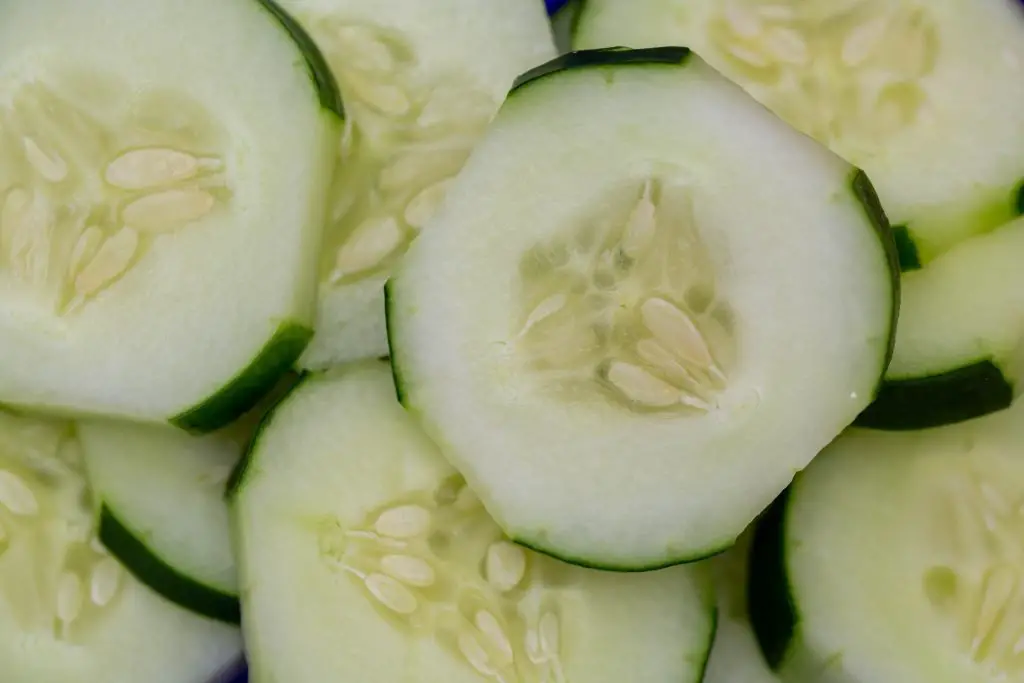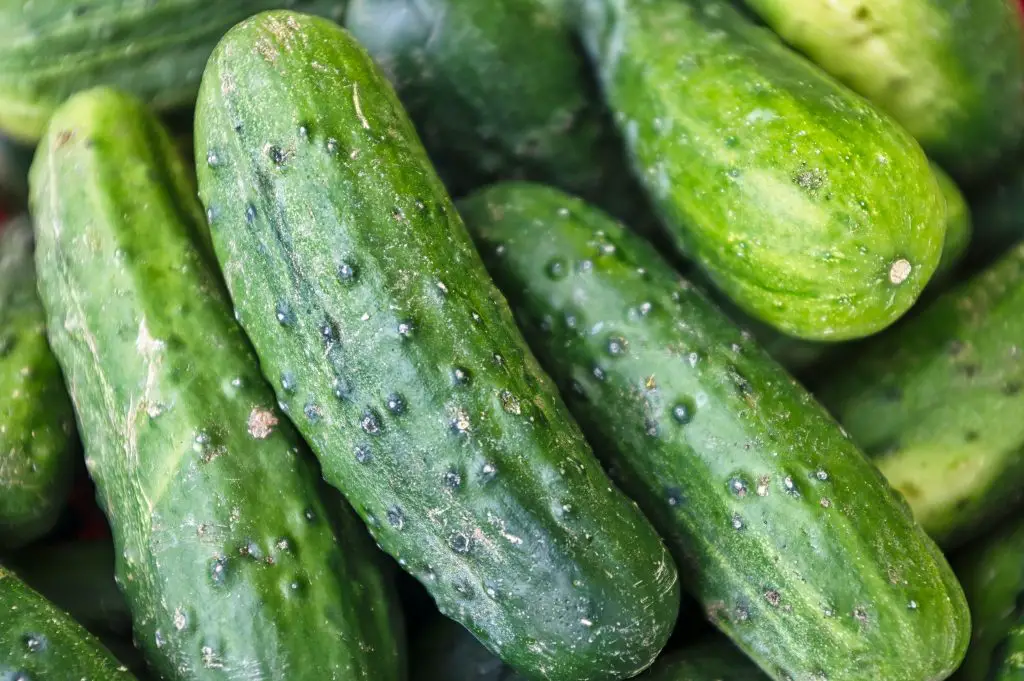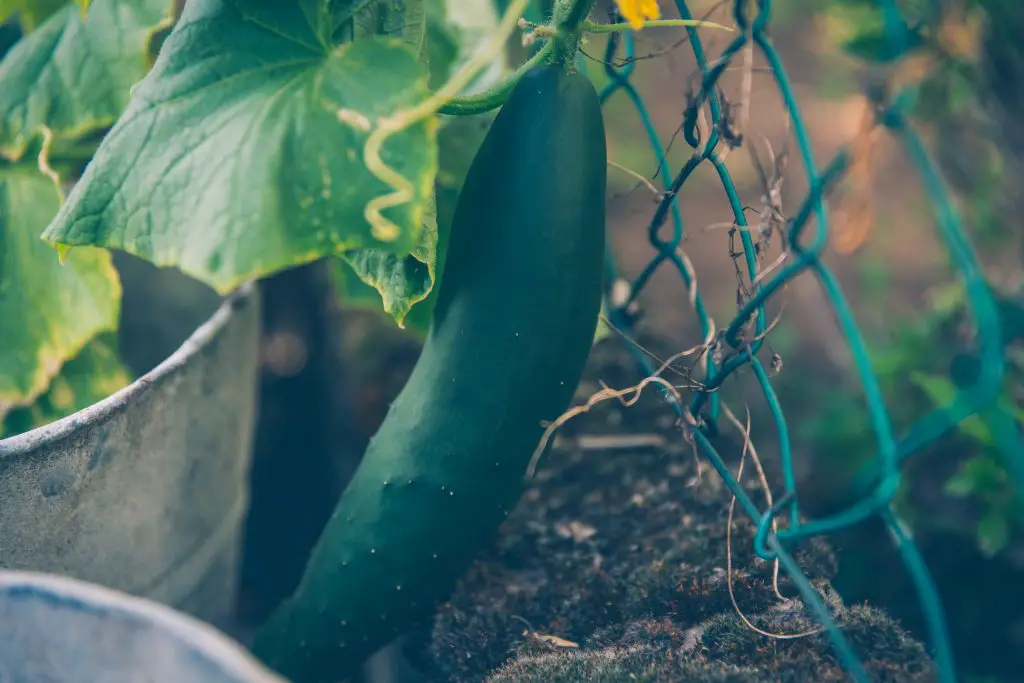How Many Cucumbers Will A Plant Produce? There is nothing better than picking a Cucumber from the garden putting it straight into a green salad or pickling your own Cucumbers to use all year round. However, to be able to do this we must know how many Cucumbers a plant produces.
A single Cucumber plant will produce usually around 10 Cucumbers per plant. The quantity of Cucumber equates to a total yield of between 4 to 6 lbs (1.8 to 2.7 kg) of fruit for a slicing Cucumber and for a pickling Cucumber 3 to 4.4 lbs (1.5 to 2 kg) of fruit can be expected.
The numbers quoted are based on studies that have been published by Cornell University, University of Maine and North Carolina State University. However, I have seen data from Australian sources that state yields up to 30 to 35 lbs (15 kg) of fruit per plant. But I suspect that the growing conditions in Australia are likely to be much more favourable than those in the US or UK due to the extend growing season and relatively mild winters.
What Are The Best Varieties Of Slicing Cucumber To Grow?
Based on the results of the trials, which have been collated in the table below the highest yielding slicing Cucumber varieties are Speedway and Dasher II. However, it should be noted that one of the trials was completed in 12 litre (3 gallon) containers while in the other trial plants were sown into the ground. The results that were grown in containers are highlighted in red and where the variety has appeared in both trials both sets of results have been given.
There are a couple of gaps in the table because I wasn’t able to find data on the seed type and the Physiology of every variety in the trials. If you know this information please leave a message in the comment session.
| Variety | Seed Type | Physiology | Yield (lbs) | Yield (Kg) |
| Speedway | F1 | Gynoecious | 6.00 | 2.72 |
| Dasher II | F1 | Gynoecious | 5.98/4.96 | 2.71/2.25 |
| Cutter | F1 | Gynoecious | 5.57 | 2.53 |
| Rockingham | F1 | Gynoecious | 5.40 | 2.45 |
| Cobra | F1 | Gynoecious | 5.26 | 2.39 |
| Marketmore 76 | Heirloom | Monoecious | 4.90/4.70 | 2.22/2.13 |
| Spacemaster | Heirloom | Gynoecious | 4.87 | 2.21 |
| Python | F1 | Gynoecious | 4.76 | 2.16 |
| Darlington | F1 | Gynoecious | 4.45 | 2.02 |
| Cherokee | F1 | Gynoecious | 4.37 | 1.98 |
| Boa | F1 | ? | 4.25 | 1.93 |
| Gold Standard | F1 | ? | 4.18 | 1.90 |
| Bush Whopper II | F1 | Monoecious | 3.90 | 1.77 |
| Bush Champion | F1 | Monoecious | 3.46 | 1.57 |
| Intimidator | F1 | Gynoecious | 3.43 | 1.56 |
As a home gardener the variety I selected for my own garden is Marketmore there are several reasons for this with the first being that Marketmore is a variety that is widely available and relatively easy to find. If you live in the US you can find it at Seeds For Generations or St Clare Seeds. In the UK try at Thompson & Morgan.
The second reason is that the Marketmore is an heirloom variety. The advantage of an heirloom varieties is that you can purchase the seed once and save the seed from the fruit for the following year. This is easily done by scraping the seed out of the fruit, washing it to remove the pith and leaving it on a paper towel to dry.
F1 hybrid varieties have seeds that a genetically unstable which means that if you collect seeds from the fruit for the following year it is unlikely that you will be able to grow a Cucumber with the same characteristics the following year. This means that you nee to purchase the seeds every year. To learn more about the difference between Hybrid and Heirloom seeds click here.
The third reason is the physiology of the plant, Cucumbers can be classified into 3 categories based on their physiology. There are Monoecious, Gynoecious and Parthenocarpic types. Marketmore is a Monoecious type.

Monoecious are Cucumbers that produce approximately equal numbers of male and female flowers on the plant. This characteristic ensures that the plant is self pollinating which means that it is not necessary to plant a second variety for cross pollination.
In Monoecious varieties it is common that the male flowers appear first usually a week or two prior to the female flowers appearing. This slight timing difference can mean that sometimes pollination can be alittle poorer than we would like. There are a few additional steps that can be taken to make 100% certain that the pollination occurs. This includes hand pollination or using a pollination spray, to read more about this click here.
Gynoecious types are plants that produce mainly female flowers on the plant, though the occasional male flower will appear. The primary advantage of these types of Cucumbers is that it produces more fruit as every female flower that appears is a potentially fruit producing bloom.
The disadvantage of Gynoecious varieties is that you need to have at least one additional plant that produces male flowers to ensure that pollination occurs. When Gynoecious varieties are sold to home gardeners they generally contain 10 to 15% of a different variety that will cross pollinate with Gynoecious variety.
So if you have a really small garden where you are planting only a few plants it is possible that you will get no fruit because you happen by chance not to select any of the second variety. Hence the reason why I prefer the Marketmore as it is Monoecious.

The third type of Cucumber, which does not appear in any of the studies is Parthenocarpic varieties. These are Cucumbers that can produce fruit without the need for pollination. This characteristic is extremely advantageous when growing fruit in the greenhouse as it avoids the need for hand pollination. However, as there is no pollination occurring no seeds are produced which means you can not save seeds for the following year.
What Are The Best Varieties Of Pickling Cucumber To Grow?
Based on the testing results from the University of Maine and North Caroline State University the best performed variety tested was Eureka. We would recommend that particular variety over the heirloom varieties tested on the basis that the yield was almost double the other Monecious varieties. The only drawback of this variety is that it is a Hybrid seed.
The data from the trials is shown in the table below. Like the previous data presented the varieties highlighted in red are those ones that were tested in containers rather planted in the ground.
| Variety | Seed Type | Physiology | Yield (lbs) | Yield (Kg) |
| Eureka | F1 | Monoecious | 5.95 | 2.70 |
| Fancipak | F1 | Gynoecious | 5.09 | 2.31 |
| Alibi | F1 | ? | 4.70 | 2.13 |
| Vlaspik | F1 | Gynoecious | 4.56 | 2.07 |
| NC-Danbury | F1 | Monoecious | 3.99 | 1.81 |
| Sassy | F1 | Gynoecious | 3.68 | 1.67 |
| Picklebush | Heirloom | Monoecious | 3.26 | 1.48 |
| Sumter | Heirloom | Monoecious | 3.09 | 1.40 |
| Northern Pickling | Heirloom | ? | 2.12 | 0.96 |
The pickled Cucumber varieties are generally more suited to growing in containers due to their size. When using containers the optimal planting density is one plant for every 3 gallons (12 litres) of soil. To read more about the impact of varying the planting density click here.
How To Grow Cucumbers
Like all Cucurbits Cucumbers are frost sensitive plants that generally perform best in warmer conditions. Cucumber seeds can be sown directly into the soil or into seed trays. My personal preference is to sow them in trays because it allows the seeds to be started indoors before the last frost which ensures that you have the earliest possible harvest.
The other reasons for using seedling trays is that reduces the time the vegetable spends in the garden which creates additional space for growing other things. Additionally, it is easier to protect young seedlings from slugs and snails.
When sowing seeds they should be sown at a depth of 1 to 2 cm (0.5 inches) with one seed per cell. When deciding on the number of seeds to plant always plant 25% to 50% more seeds that you require for the garden to ensure you can replace any seedlings that may get damaged.
If you are planting seeds in the early part of the growing season it is best to store the seed trays in a heated location. The easiest way to do this is to use a heated propagation tray. They are relatively cheap and easy to use. Click here to see the latest price on Amazon.
Once seeds are planted it will take between 4 and 6 weeks for them to reach a large enough size for them to be planted outside into the garden. When planting the seedlings outside select a warm sunny location that gets at least 6 to 8 hours of sun per day. The plants should be planted 10 to 12 inches (25 to 30 cm) apart into moist rich soil that contains plenty of organic matter.

To ensure that the soil remains moist a thick layer of mulch should be applied around the base of the plant along with snail pallets to product the seedlings.
As the Cucumber plants produce vines you have the option to allow the plants trail along the ground or alternatively they can be trained up a trellis to save space. My personal preference it to train them on to a trellis to avoid the Cucumbers from coming in contact with soil and rotting. However if you do decide to let them run along the ground you may want to consider planting corn with them to maximise the output from your garden.
When growing Cucumber it is important that the plants remain well watered to ensure that the soil remains moist otherwise the Cucumbers can become bitter. It will typically take 10 to 12 weeks for the Cucumber to produce its first fruit.
When harvesting Cucumber as a general rule it is better pick the fruits too early rather than too late. This is because Cucumbers only show physical changes such as softening or discolouration of the fruit when the are over ripe. They ideally should be picked when they are green and firm. To read more about the click here.
Relevant Articles
Why do my cucumbers bloom but don’t produce?
Can You Pick A Cucumber Too Early?
How many cucumbers grow in a container?
What Makes Cucumber Turn Yellow? And Are They Still Edible?
